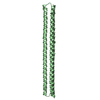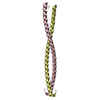[English] 日本語
 Yorodumi
Yorodumi- PDB-2ba2: Crystal structure of the DUF16 domain of MPN010 from Mycoplasma p... -
+ Open data
Open data
- Basic information
Basic information
| Entry | Database: PDB / ID: 2ba2 | ||||||
|---|---|---|---|---|---|---|---|
| Title | Crystal structure of the DUF16 domain of MPN010 from Mycoplasma pneumoniae | ||||||
 Components Components | Hypothetical UPF0134 protein MPN010 | ||||||
 Keywords Keywords |  STRUCTURAL GENOMICS / UNKNOWN FUNCTION / DUF16 / MPN010 / STRUCTURAL GENOMICS / UNKNOWN FUNCTION / DUF16 / MPN010 /  hypothetical protein / hypothetical protein /  coiled-coil / coiled-coil /  stutter / PSI / stutter / PSI /  Protein Structure Initiative / Berkeley Structural Genomics Center / BSGC Protein Structure Initiative / Berkeley Structural Genomics Center / BSGC | ||||||
| Function / homology | Single alpha-helices involved in coiled-coils or other helix-helix interfaces - #40 / Domain of unknown function DUF16 / Protein of unknown function DUF16 / Single alpha-helices involved in coiled-coils or other helix-helix interfaces / Helix non-globular / Special / UPF0134 protein MPN_010 Function and homology information Function and homology information | ||||||
| Biological species |  Mycoplasma pneumoniae (Filterable agent of primary atypical pneumonia) Mycoplasma pneumoniae (Filterable agent of primary atypical pneumonia) | ||||||
| Method |  X-RAY DIFFRACTION / X-RAY DIFFRACTION /  SYNCHROTRON / SYNCHROTRON /  SAD / Resolution: 1.8 Å SAD / Resolution: 1.8 Å | ||||||
 Authors Authors | Shin, D.H. / Kim, J.-S. / Yokota, H. / Kim, R. / Kim, S.-H. / Berkeley Structural Genomics Center (BSGC) | ||||||
 Citation Citation |  Journal: Protein Sci. / Year: 2006 Journal: Protein Sci. / Year: 2006Title: Crystal structure of the DUF16 domain of MPN010 from Mycoplasma pneumoniae. Authors: Shin, D.H. / Kim, J.-S. / Yokota, H. / Kim, R. / Kim, S.-H. | ||||||
| History |
|
- Structure visualization
Structure visualization
| Structure viewer | Molecule:  Molmil Molmil Jmol/JSmol Jmol/JSmol |
|---|
- Downloads & links
Downloads & links
- Download
Download
| PDBx/mmCIF format |  2ba2.cif.gz 2ba2.cif.gz | 62.8 KB | Display |  PDBx/mmCIF format PDBx/mmCIF format |
|---|---|---|---|---|
| PDB format |  pdb2ba2.ent.gz pdb2ba2.ent.gz | 47 KB | Display |  PDB format PDB format |
| PDBx/mmJSON format |  2ba2.json.gz 2ba2.json.gz | Tree view |  PDBx/mmJSON format PDBx/mmJSON format | |
| Others |  Other downloads Other downloads |
-Validation report
| Arichive directory |  https://data.pdbj.org/pub/pdb/validation_reports/ba/2ba2 https://data.pdbj.org/pub/pdb/validation_reports/ba/2ba2 ftp://data.pdbj.org/pub/pdb/validation_reports/ba/2ba2 ftp://data.pdbj.org/pub/pdb/validation_reports/ba/2ba2 | HTTPS FTP |
|---|
-Related structure data
| Similar structure data | |
|---|---|
| Other databases |
- Links
Links
- Assembly
Assembly
| Deposited unit | 
| ||||||||
|---|---|---|---|---|---|---|---|---|---|
| 1 |
| ||||||||
| Unit cell |
|
- Components
Components
| #1: Protein | Mass: 9789.110 Da / Num. of mol.: 3 / Fragment: DUF16 domain, residues 46-130 Source method: isolated from a genetically manipulated source Source: (gene. exp.)  Mycoplasma pneumoniae (Filterable agent of primary atypical pneumonia) Mycoplasma pneumoniae (Filterable agent of primary atypical pneumonia)Plasmid: pB3, pET21a derived / Production host:   Escherichia coli (E. coli) / Strain (production host): B834(DE3), pSJS1244 / References: UniProt: P75103 Escherichia coli (E. coli) / Strain (production host): B834(DE3), pSJS1244 / References: UniProt: P75103#2: Water | ChemComp-HOH / |  Water Water |
|---|
-Experimental details
-Experiment
| Experiment | Method:  X-RAY DIFFRACTION / Number of used crystals: 1 X-RAY DIFFRACTION / Number of used crystals: 1 |
|---|
- Sample preparation
Sample preparation
| Crystal | Density Matthews: 1.91 Å3/Da / Density % sol: 33.3 % |
|---|---|
Crystal grow | Temperature: 298 K / Method: vapor diffusion, hanging drop / pH: 7.5 Details: 0.2M lithium Sulfate, 25% PEG3350, 0.1M HEPES, pH 7.5, VAPOR DIFFUSION, HANGING DROP, temperature 298K |
-Data collection
| Diffraction | Mean temperature: 90 K |
|---|---|
| Diffraction source | Source:  SYNCHROTRON / Site: SYNCHROTRON / Site:  ALS ALS  / Beamline: 8.2.2 / Wavelength: 0.97938 Å / Beamline: 8.2.2 / Wavelength: 0.97938 Å |
| Detector | Type: ADSC QUANTUM 4 / Detector: CCD / Date: Jan 11, 2005 / Details: Monochromator |
| Radiation | Monochromator: Double crystal / Protocol: SINGLE WAVELENGTH / Monochromatic (M) / Laue (L): M / Scattering type: x-ray |
| Radiation wavelength | Wavelength : 0.97938 Å / Relative weight: 1 : 0.97938 Å / Relative weight: 1 |
| Reflection | Resolution: 1.8→42.01 Å / Num. all: 40349 / Num. obs: 32441 / % possible obs: 80.4 % / Observed criterion σ(F): 0 / Observed criterion σ(I): -3 / Biso Wilson estimate: 17.3 Å2 |
| Reflection shell | Resolution: 1.8→1.83 Å / % possible all: 13 |
- Processing
Processing
| Software |
| |||||||||||||||||||||||||
|---|---|---|---|---|---|---|---|---|---|---|---|---|---|---|---|---|---|---|---|---|---|---|---|---|---|---|
| Refinement | Method to determine structure : :  SAD / Resolution: 1.8→19.55 Å / Rfactor Rfree error: 0.007 / Data cutoff high absF: 215255.05 / Data cutoff low absF: 0 / Isotropic thermal model: RESTRAINED / Cross valid method: THROUGHOUT / σ(F): 0 SAD / Resolution: 1.8→19.55 Å / Rfactor Rfree error: 0.007 / Data cutoff high absF: 215255.05 / Data cutoff low absF: 0 / Isotropic thermal model: RESTRAINED / Cross valid method: THROUGHOUT / σ(F): 0
| |||||||||||||||||||||||||
| Solvent computation | Solvent model: FLAT MODEL / Bsol: 67.6333 Å2 / ksol: 0.405914 e/Å3 | |||||||||||||||||||||||||
| Displacement parameters | Biso mean: 31.1 Å2
| |||||||||||||||||||||||||
| Refine analyze |
| |||||||||||||||||||||||||
| Refinement step | Cycle: LAST / Resolution: 1.8→19.55 Å
| |||||||||||||||||||||||||
| Refine LS restraints |
| |||||||||||||||||||||||||
| LS refinement shell | Resolution: 1.8→1.91 Å / Rfactor Rfree error: 0.042 / Total num. of bins used: 6
| |||||||||||||||||||||||||
| Xplor file |
|
 Movie
Movie Controller
Controller












 PDBj
PDBj
